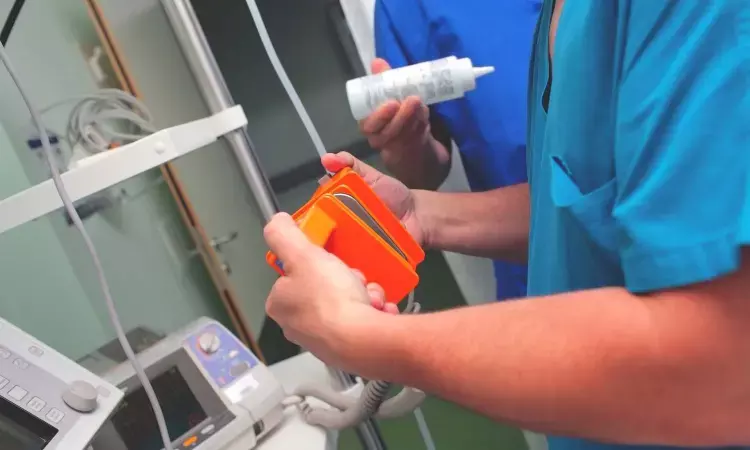- Home
- Medical news & Guidelines
- Anesthesiology
- Cardiology and CTVS
- Critical Care
- Dentistry
- Dermatology
- Diabetes and Endocrinology
- ENT
- Gastroenterology
- Medicine
- Nephrology
- Neurology
- Obstretics-Gynaecology
- Oncology
- Ophthalmology
- Orthopaedics
- Pediatrics-Neonatology
- Psychiatry
- Pulmonology
- Radiology
- Surgery
- Urology
- Laboratory Medicine
- Diet
- Nursing
- Paramedical
- Physiotherapy
- Health news
- Fact Check
- Bone Health Fact Check
- Brain Health Fact Check
- Cancer Related Fact Check
- Child Care Fact Check
- Dental and oral health fact check
- Diabetes and metabolic health fact check
- Diet and Nutrition Fact Check
- Eye and ENT Care Fact Check
- Fitness fact check
- Gut health fact check
- Heart health fact check
- Kidney health fact check
- Medical education fact check
- Men's health fact check
- Respiratory fact check
- Skin and hair care fact check
- Vaccine and Immunization fact check
- Women's health fact check
- AYUSH
- State News
- Andaman and Nicobar Islands
- Andhra Pradesh
- Arunachal Pradesh
- Assam
- Bihar
- Chandigarh
- Chattisgarh
- Dadra and Nagar Haveli
- Daman and Diu
- Delhi
- Goa
- Gujarat
- Haryana
- Himachal Pradesh
- Jammu & Kashmir
- Jharkhand
- Karnataka
- Kerala
- Ladakh
- Lakshadweep
- Madhya Pradesh
- Maharashtra
- Manipur
- Meghalaya
- Mizoram
- Nagaland
- Odisha
- Puducherry
- Punjab
- Rajasthan
- Sikkim
- Tamil Nadu
- Telangana
- Tripura
- Uttar Pradesh
- Uttrakhand
- West Bengal
- Medical Education
- Industry
Double shock from two defibrillators may increase frequency of survival after cardiac arrest

Shock-refractory ventricular fibrillation remains common during out-of-hospital cardiac arrest inspite of advancements in defibrillation technology.
Researchers have found in a new study that Double sequential external defibrillation or VC defibrillation compared to standard defibrillation resulted in more frequent survival to hospital discharge among among patients with refractory ventricular fibrillation.
Dr. Sheldon Cheskes, a Heart & Stroke funded researcher, and Professor of Emergency Medicine in the Department of Family and Community Medicine at the University of Toronto, and his team conducted the four-year trial across six paramedic services in Ontario, which included 4000 paramedics.
The study, presented at the American Heart Association Resuscitation Science Symposium-Late Breaking Trials, compared two novel techniques to standard care for patients receiving care from paramedics involved in the trial. All patients who remained in ventricular fibrillation (VF) after 3 shocks, using standard defibrillation techniques, continued to receive defibrillation using standard defibrillation techniques or one of the following strategies:
One technique, double sequential external defibrillation (DSED), involved applying a second set of pads from a second defibrillator to the patient and sequentially shocking the patient using the two defibrillators.The second technique, vector change defibrillation (VC Defibrillation), involved changing the standard pad position known as anterior-lateral pad to anterior-posterior pads.
Remarkably, DSED was found to significantly improve both survival and neurological outcomes while vector change defibrillation improved survival when compared to the current standard of care. Survival to hospital discharge was 30.4% in the DSED group compared to 21.7% in the vector change group and 13.3% in the standard care group. These findings are most notable for first responders when standard methods of external defibrillation are ineffective.
"I am so proud of the paramedics who were trained and took part in the trial, as they clearly demonstrated that these new strategies could improve outcomes for these patients," says Dr. Cheskes, who is also a scientist at St. Michael's Hospital, a site of Unity Health Toronto. "This trial has the potential to change practice around the world while saving the lives of patients sustaining refractory ventricular fibrillation."
An estimated 35,000 out of hospital cardiac arrests happen each year in Canada. This means, on average, one cardiac arrest every 15 minutes. Cardiac arrest can strike anyone, anywhere, anytime, at any age, without warning.
Currently, 80% of cardiac arrests occur outside of a hospital setting and nine in ten of these people do not survive. Performing CPR and using AED on a person experiencing cardiac arrest can double their chance of survival.
Dr Kamal Kant Kohli-MBBS, DTCD- a chest specialist with more than 30 years of practice and a flair for writing clinical articles, Dr Kamal Kant Kohli joined Medical Dialogues as a Chief Editor of Medical News. Besides writing articles, as an editor, he proofreads and verifies all the medical content published on Medical Dialogues including those coming from journals, studies,medical conferences,guidelines etc. Email: drkohli@medicaldialogues.in. Contact no. 011-43720751


